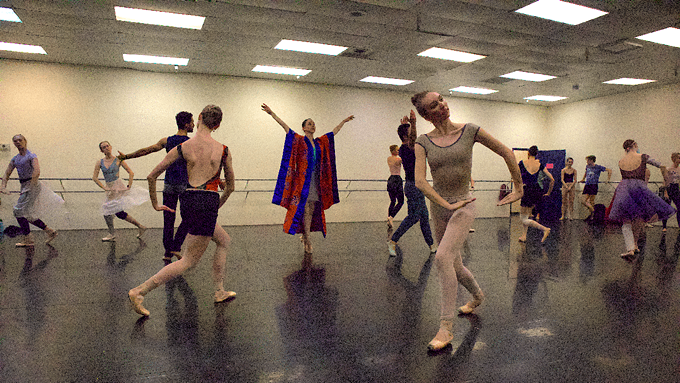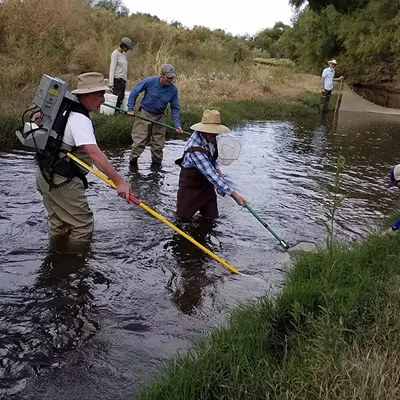
Ballet Tucson partners with the Tucson Desert Song Festival to present their 2023 Winter Concert, featuring four premieres centered around love, legends and inspired by the event’s theme, “heroes and villains.”
This year’s concert will feature some of the company’s most challenging and exploratory work. The world premiere of “Himiko” is Chieko Imada’s opportunity to showcase her skill and culture.
The accomplished Japanese-born dancer has lived and worked in Tucson for more than 30 years.
Along with dancing and teaching for Inoue Ballet of Tokyo, she’s worked with big state companies like Ballet Arizona, Ortz Theatre of Dance and Tenth St. Danceworks. But it was as Ballet Tucson’s associate artistic director and resident choreographer she found the chance to tell Queen Himiko’s story.
“I always knew Himiko in my mind as a hero,” Imada said. “Himiko is a powerful female figure, and I was always attracted by her character. Years ago, when I came here, I knew I wanted to do something based on her.”
While not much is known about the mysterious third century ruler, Queen Himiko is considered the great uniter of Japan. She was a legendary shamaness that Imada brought to life through her choreography, brimming with passion.
Imada’s focus on emotion-filled movements has a lot to do with her love of drama. To her, the dancers aren’t solely moving their bodies — they’re telling stories with each step. Ballet Tucson’s Artistic Director Margaret Mullin, a former student of Imada, praised her colleague’s ability.
“It’s a deep reflection on what it means to actually be a leader,” Mullin said about the piece. “I was moved when Chieko talked about exploring the pressure around it — the weight of responsibility but also the hope for the future.”
In “Himiko,” the renowned choreographer also incorporated Japanese dancing to further its authenticity. Imada studied the style when she lived in Japan, and wanted to blend it with ballet and contemporary dances. To her, it was “a merging of East and West.”
Imada worked on this “merging” with the Tucson Desert Song Festival, an organization that celebrates classical music in the Southwest and around the world. Each year, the festival partners with organizations around the city to encourage local collaboration.
“I think it’s so special what they do. They try to spread across Tucson to create unique arts experiences,” Mullin said.
The festival introduced Imada to Duo Chinoiserie, a partnership of Chinese guzheng performer Jing Xia and classical guitarist Bin Hu. The duo is globally known for their expert Chinoiserie style, combining the music traditions of East and West.
Imada worked with one of their composers, Yusuke Nakanishi, to expand a few pieces she planned to use in the show. Thanks to the festival and the Tucson Guitar Society, Ballet Tucson’s “Himiko” will feature the live onstage accompaniment of Duo Chinoiserie.
Imada acknowledged the talent of the duo, discussing Xia’s specific skill with the guzheng when they came to the studio.
“Their music touched us,” Imada said. “Immediately, when she played the instrument, the warm plink of sound showed 5,000 years of history. There was depth in a single note, she really puts her soul into it.”
The winter concert will be the official world premiere of “Himiko,” along with Ballet Tucson’s first collaboration with Duo Chinoiserie. Along with the piece, the company will perform three other numbers that fit the themes of love and legends, heroes and villains.
“Allegro Brillante” is everything legendary choreographer George Balanchine claimed he knew about ballet in 13 minutes. With permission from the George Balanchine Trust, Ballet Tucson will share a repertory piece with two of the largest ballets in the United States — the Pacific Northwest Ballet and New York City Ballet.
“Allegro Brillante is considered one of his hardest ballets,” Mullin said. “Having something of this quality is a big testament to where Ballet Tucson is as a company.”
In the spirit of Valentine’s Day, Ballet Tucson will also perform Romeo and Juliet’s famous “Pas de Deux,” featuring the famous balcony scene from the Shakespeare play. Choreographed by Mullin, the piece features the musical work of Sergei Prokofiev. She said she hopes the piece will remind audience members of the power and excitement of the first time they fell in love.
Ballet Tucson’s fourth premiere is “Borderland,” which explores the haunting barrier between consciousness — being awake and asleep. The neoclassical work was produced by Mullin’s former colleague, Price Suddarth, an up-and-coming choreographer with a flair for experimentation. While it’s still considered ballet, the piece explores the different ways dancers can move their bodies and feet.
Altogether, “Borderland,” “Romeo and Juliet,” “Allegro Brillante” and “Himiko”’ are the diverse and varied stories Ballet Tucson will tell in its upcoming winter concert. The company will perform in the Leo Rich Theater at 7 p.m. Friday, Feb. 17, and 2 p.m. Saturday, Feb. 18, and Sunday, Feb. 19.
Altogether, Imada and the company will showcase a premiere 30 years in the making, in which the accomplished dancer dreamt with each pointe-shoed step.
“We can do so much with steps,” Imada said. “Finally, after three decades, it’s a dream come true. I appreciate it.”
Ballet Tucson: Winter Concert
WHEN: 7 p.m. Friday, Feb. 17, and 2 p.m. Saturday, Feb. 18, and Sunday, Feb. 19
WHERE: Leo Rich Theater, 260 S. Church Street, Tucson
COST: Tickets start at $30
INFO: ballettucson.org











